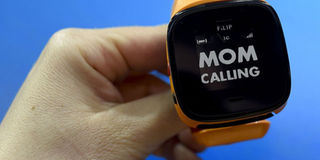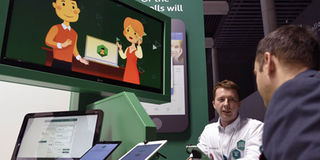Smart wearables all the rage at 2015 Mobile World Congress

A hostess presents a watch "FiLIP" by Telefonica during the 2015 Mobile World Congress (MWC) in Barcelona on March 3, 2015. PHOTO | AFP
What you need to know:
- Whereas the main attraction to the expo has traditionally been handsets, this year was defined by the explosion of “wrist technology” in fitness trackers, smartbands, and smartwatches.
- Chinese mobile maker, Huawei, launched its android watches but it was the South Korean firm LG unveiling of its luxury wristwatch, the LG Watch Urbane LTE, that was a game-changer.
- Apple, which has traditionally kept off the fair, launched its Apple Watch in what industry insiders say could offer an insight in the future of the wearable.
The future of internet will be with us in 2020; 2015 will be the year of the wearable.
That was the long and short of the conclusion made at the Mobile World Congress, held in Barcelona, Spain last week.
Mobile World Congress is defined as the biggest wireless telecom fair internationally.
Whereas the main attraction to the expo has traditionally been handsets, this year was defined by the explosion of “wrist technology” in fitness trackers, smartbands, and smartwatches.
The event marked a year since the emergence of Android watches ushering in the era of wearable.
Chinese mobile maker, Huawei, launched its android watches but it was the South Korean firm LG unveiling of its luxury wristwatch, the LG Watch Urbane LTE, that was a game-changer.
While other wearable are linked to a mobile handset, LG Watch Urbane LTE comes with its own SIM network card that lets the wearer make calls, receive emails and search the web from their wrist.
Apple, which has traditionally kept off the fair, launched its Apple Watch in what industry insiders say could offer an insight in the future of the wearable.
South Korean firm SK Telecom gave an insight of the future of internet by demonstrating a robot whose movements mimicked those of a person wearing a set of wireless sensors.

A man operates an SK telecom robot during the 2015 Mobile World Congress (MWC) in Barcelona on March 3, 2015. PHOTO | AFP
SK Telecom hopes that by 2020, when the world officially moves to 5G technology, the robot would support remote-controlled robots carrying out surgery or working in disaster zones.
The robot’s wireless signal is transmitted through a prototype of a “5G” network — the next generation of ultra-fast and reliable mobile coverage.
Launch of 5G technology is expected to usher in the Internet of Things, where ultra-fast and broadband connectivity would enable wireless connection of devices allowing deployment of self-driving cars, which may explain why this year’s congress attracted almost all big car makers. The demand for a more connected cars is high.
“I probably can’t meet with all the car companies that are calling,” jokes Ericsson senior vice-president Ulf Ewadsson to journalists at the congress. “They’re transforming their industry and there’s a serious drive for change.”

A technician explains how the Kaspersky antivirus aims to protect children during the 2015 Mobile World Congress in Barcelona on March 4, 2015. Kaspersky has become the focal point in an escalating conflict in cyberspace between the US and Russia.PHOTO | AFP
By 2020, it is believed that 70 per cent of the world’s population would have mobile broadband coverage.
Kenya has an ambitious target of connecting 35 per cent of households in the country and 100 per cent of hospitals and school by 2017.
Well, for those travelling, Californian tech company Bluesmart has made a “smart suitcase” that promises to save time by weighing itself and letting the user track it constantly via a smartphone app.
Spanish company Telefonica announced at the show that it would provide mobile connections to run the trackable case.
TRENDS 2015
Five top digital trends emerge at 2015 expo

GRAPHIC | COURTESY | ERICSSON
Tech companies showcased countless connected gadgets at the world’s biggest wireless telecom fair, the Mobile World Congress in Barcelona, Spain, which wrapped up on Thursday. Here is a selection of highlights:
Curvy smartphones
The world’s biggest phone-maker, South Korean firm Samsung, stole the show for handsets, moving to compete against Apple’s iPhone 6 Plus with its own new flagship smartphone, the S6 Galaxy Edge: super-slim, weighing 132 grammes (4.7 ounces) with a five-inch screen that curves around the edges and a wireless charger.
Connected smartwatches
South Korean firm LG unveiled a luxury wristwatch, the LG Watch Urbane LTE, with its own SIM network card that lets the wearer make calls, receive emails and search the web from their wrist.
Unlike previous smartwatch models, it does not need to be linked to a mobile phone.
Numerous other firms released smartwatches, looking for a foothold before Apple launches its Apple Watch in April.
Virtual Reality Headset

A visitor uses a visual device during the 2015 Mobile World Congress (MWC) in Barcelona on March 3, 2015. PHOTO | AFP
Hip Taiwanese phone maker HTC presented a virtual reality headset that it promises to launch as a consumer product this year.
Chunky black plastic strapped around your head on the outside, with 360-degree virtual worlds inside that immerse the viewer in video games or films.
Tech bloggers hailed it as a game-changer for virtual reality entertainment to compete with another forthcoming VR device, Oculus Rift.
Remote-control Robots
South Korean operator SK Telecom demonstrated a robot whose movements mimicked those of a person wearing a set of wireless sensors.
The wireless signal was transmitted through a prototype of a “5G” network — the next generation of ultra-fast and reliable mobile coverage.
Operators hope that from the year 2020 5G will be able to support activities such as remote-controlled robots carrying out surgery or working in disaster zones.
Connected Suitcase
Californian tech company Bluesmart has made a “smart suitcase” that promises to save stress for travellers by weighing itself and letting the user track it constantly via a smartphone application.
Spanish company Telefonica announced at the show that it will provide mobile connections to operate the trackable case.




